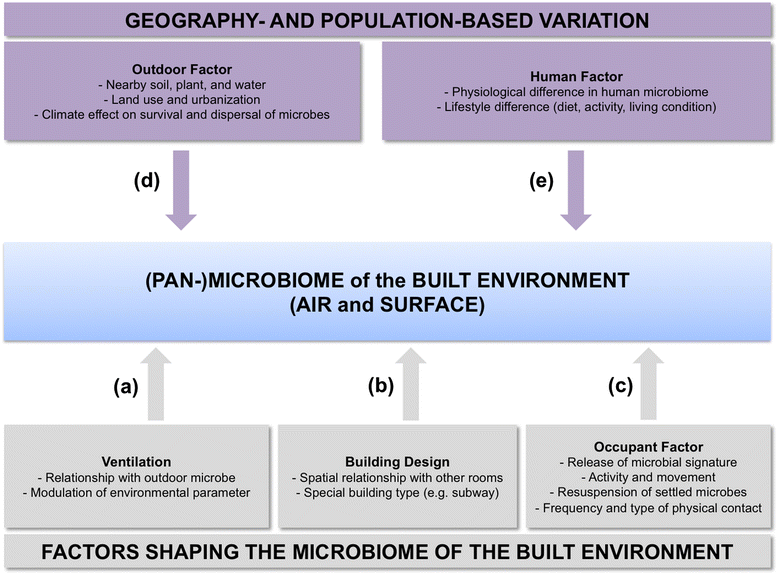The roles of the outdoors and occupants in contributing to a potential pan-microbiome of the built environment: a review
- PMID: 27216717
- PMCID: PMC4877933
- DOI: 10.1186/s40168-016-0165-2
The roles of the outdoors and occupants in contributing to a potential pan-microbiome of the built environment: a review
Abstract
Recent high-throughput sequencing technology has led to an expansion of knowledge regarding the microbial communities (microbiome) across various built environments (BEs). The microbiome of the BE is dependent upon building factors and conditions that govern how outdoor microbes enter and persist in the BE. Additionally, occupants are crucial in shaping the microbiome of the BE by releasing human-associated microorganisms and resuspending microbes on floors and surfaces. Therefore, both the outdoors and occupants act as major sources of microorganisms found in the BE. However, most characterizations of the microbiome of the BE have been conducted in the Western world. Notably, outdoor locations and population groups present geographical variations in outdoor and human microbiomes, respectively. Given the influences of the outdoor and human microbiomes on BE microbiology, and the geographical variations in outdoor and human microbiomes, it is likely that the microbiomes of BEs also vary by location. The summation of microbiomes between BEs contribute to a potential BE pan-microbiome, which will both consist of microbes that are ubiquitous in indoor environments around the world, and microbes that appear to be endemic to particular geographical locations. Importantly, the BE pan-microbiome can potentially question the global application of our current views on indoor microbiology. In this review, we first provide an assessment on the roles of building and occupant properties on shaping the microbiome of the BE. This is then followed by a description of geographical variations in the microbiomes of the outdoors and humans, the two main sources of microbes in BEs. We present evidence of differences in microbiomes of BEs around the world, demonstrating the existence of a global pan-microbiome of the BE that is larger than the microbiome of any single indoor environment. Finally, we discuss the significance of understanding the BE pan-microbiome and identifying universal and location-specific relationships between building and occupant characteristics and indoor microbiology. This review highlights the much needed efforts towards determining the pan-microbiome of the BE, thereby identifying general and location-specific links between the microbial communities of the outdoors, human, and BE ecosystems, ultimately improving the health, comfort, and productivity of occupants around the world.
Keywords: Building designs; Geography; Human microbiome; Indoor built environments; Outdoor air; Pan-microbiome.
Figures


References
Publication types
MeSH terms
Substances
LinkOut - more resources
Full Text Sources
Other Literature Sources
Medical

